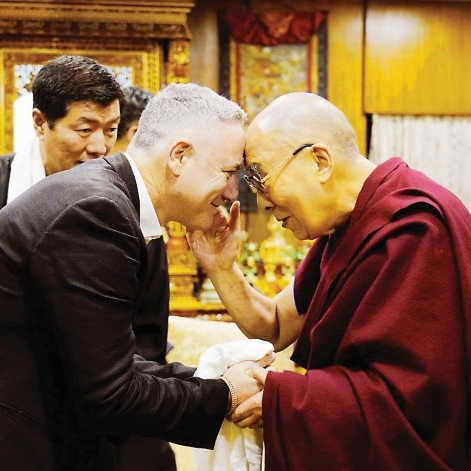
SA

Can the Dalai Lama play a role in Israeli-Palestinian peace?
TALI FEINBERG
The revered Tibetan icon’s philosophy of non-violence may be the key to resolving tension in the Middle East. According to activists, we just need to give it a chance.
This is the vision of Guy Lieberman, South African-born social entrepreneur and activist who last week brought Israeli and Palestinian delegates together in the Dalai Lama’s home in Dharamsala, India. They engaged in a week-long exploration of non-violence and exploring how Israeli and Palestinian narratives have points of intersect with the Tibetan narrative.
Lieberman has been an activist for the Tibetan freedom struggle since first meeting the Dalai Lama in 1994 at the age of 23. In mid-2017, he made aliyah with his family from Johannesburg to Zichron Yaakov. He realised along the way the parallels which existed between the Tibetan struggle and that of Israel-Palestine.
The Tibetans were invaded by Maoist China in 1949, and in spite of ongoing oppression, they continue to wage a peaceful campaign for independence and genuine autonomy under China. Lieberman therefore arranged this special meeting, bringing together his “Tibetan Zeida” and activists representing Chevron, Gaza, Kabul, and the Israeli settlement of Tekoa.
The group mapped out their respective narratives, finding shared experiences, and discussing ways to use them to solve the impasse faced in the Middle East.
“The Tibetans hope to regain their land, as Jews did for 2 000 years,” says Lieberman. “They look to the Jews as a brave nation that finally got their Holy Land back, and yet they feel simultaneously allied with the Palestinians. The Tibetans have heard both narratives, but they side with neither. It makes sense to explore new modalities to dealing with the conflict with such a neutral yet wise advisor.”
Lieberman said the meeting was inspiring, full of humour and simple wisdom. “It was clear to those in the room that we shared a common humanity based on trust, care, and kindness,” he told the SA Jewish Report.
“The Tibetans have taken a view inspired by a deep and compassionate Buddhist perspective that insists that violence begets violence, and karma is infallible; what you give out, you will eventually receive in return, act for act.
“This is a total departure from the approach to conflict that Israelis and Palestinians hold; that we need to kill or die for what’s rightfully ours. As the Dalai Lama said, “For how long does this go on? Regardless of your history, the current reality is that you need to live side by side.”
Lieberman recognises that this is a tough pill for both parties to swallow. Indeed, the participants included a young Jewish mother who was stabbed by a teenage terrorist while she was pregnant. There was an Arab administrator who handles cases of “collateral damage” on the Arab side, including mistaken killings at checkpoints and respiratory issues experienced by children and the elderly caused by Israeli teargas.
“We can very easily blame the Palestinians for their part in the struggle as they equally blame us,” says Lieberman. “This blaming has helped very little, and in the meantime, families caught in the conflict are suffering. While we can’t expect the mistrust to suddenly turn into friendship, we could commit to putting down the weapons and resisting the urge to return to violence when things get heated.”
Although there are presently no plans for further meetings, Lieberman remains determined to resolve the political impasse, stressing the need to overcome our fear of the other.
“Like many in our community, I believe that there are extremely dangerous elements in the Palestinian world,” he concludes. “I’m not washing over this reality. However, the more I look into it and the more actual human Palestinians I interact with, the more I realise that there is a silent majority that we have not been able to meet and connect with.
“Repairing the human fabric in the region could do wonders for all of us who live here and in the diaspora. It’s worth the effort to open our minds and hearts and see what comes.”




